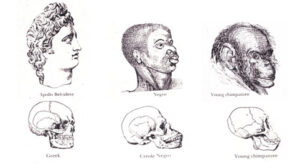
Credit: Wikipedia, scan from “The Mismeasure of Man” published 1857 by Josiah Clark Nott and George
Robert Gliddon
Descent of Man.
The mid-nineteenth century marked a period of significant advancement in understanding human biology. Two developments were later appropriated by scientists in developing theories of genetic heritability-Charles Darwin’s publication of The Origin of Species (1859), which provided a theory of evolutionthe transformation of a species of organic life over long periods of time (macroevolution) or... More that became the basis for understanding racial diversity, and Gregor Johann Mendel’s experimental work on heredity in plants.
Mendel’s account of the experiments and his conclusions, published in 1866, were largely ignored during his lifetime, but were rediscovered in 1900, and became the basic tenets of geneticsthe study of human heredity, its mechanisms and related biological variation. Heredity may be studied... More. In The Descent of Man (1871), Charles Darwin discussed the origins of racea recent idea created by western Europeans following exploration across the world to account for... More, and noted naturalists’ great difficulty in determining an exact number of “races.” Darwin, a monogenist on the question of race, believed that all humans were of the same species and found “race” to be a somewhat arbitrary distinction between groups.
- In 1851, Louisiana plantation doctor Samuel Cartwright tried to explain the tendency of black slaves to flee captivity by proposing a psychiatric diagnosis that he called “drapetomania.” The term was derived from the Greek drapetes, or runaway, and mania, or madness. Cartwright suggested in New Orleans Medical and Surgical Journal that slave owners could treat and cure this medical disorder by whipping slaves and amputating their toes.
- J. Marion Sims, considered the “father of American gynecology,” moved to Alabama from Philadelphia after his first two patients died. There, Sims developed a technique to repair a condition in women called vesicovaginal fistula, which was usually the result of traumatic labor. This new technique to repair the condition became the standard procedure. He also devised instruments, including the Sims’ speculum, to perform the surgery. In 1852, his technique using silver sutures led to the successful repair of fistulas, but he operated on his slave subjects, Anarcha, Betsy, and Lucy, approximately 40 times without the use of anesthesia, despite the fact that it was widely available.
- Paul Broca, a French pathologist, anthropologist and pioneer in neurosurgery, was a founder of the Anthropological Society of Paris (1859) and the Revue d’anthropologie (1872). He identified the brain area for articulate speech, which became known as Broca’s area, and developed methods of classifying hair and skin color. He established brain and skull ratios-cranial anthropometry-and even created instruments used in measuring and calculating indices such as craniometers. Using anthropometric methods, Broca devised a Eurocentric classificationThe ordering of items into groups on the basis of shared attributes. Classifications are cultural... More that purported to establish a relationship between anatomical features of the brain and mental capabilities.
- Sir Francis Galton, a British anthropologist, pioneered the field of eugenicsfrom Greek eugenes meaning wellborn; The eugenics movement of the late nineteenth and early twentieth... More, which sought to improve and control human hereditary traits. Especially intrigued by Charles Darwin’s work, The Origin of Species, Galton devoted much of his life to exploring its implications. He devised techniques such as composite photography in order to establish racial and social “types.” He was a proponent of selective human breeding to halt what he saw as the decline of the British race. His advocacy of selective breeding was influential in the development of eugenics-a term Galton coined-in the U.S. and later adopted by the Nazi party. He published Hereditary Genius (1869) in which he asserted that talent is an inherited characteristic and established a system of classifying fingerprints that is still used today. In 1883, Galton wrote Inquiries into Human Faculty.
Related Posts

Credit: National Archives and Records Administration
this troublesome practice that many Negroes have of running away can be almost entirely prevented.”
– Samuel Cartwright
Plantation doctor Samuel Cartwright advised whipping and toe amputation as the most effective treatments for drapetomania, a term he coined to describe the tendency of slaves to run away. The slave pictured above was named Peter. The photo was taken in Baton Rouge, Louisiana, in 1863, after Peter had been whipped by a plantation a overseer, resulting in bedsores and permanent scarring.




